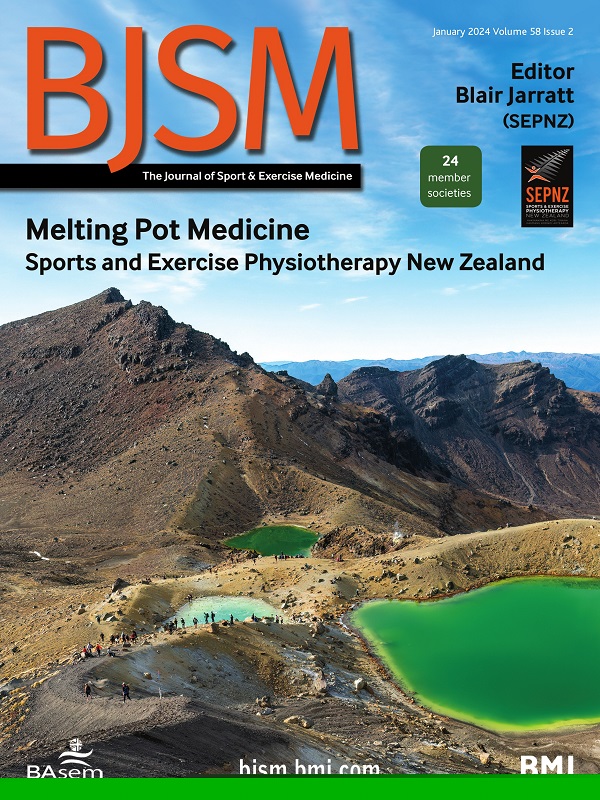Best practice guide for patellofemoral pain based on synthesis of a systematic review, the patient voice and expert clinical reasoning.
IF 11.6
1区 医学
Q1 SPORT SCIENCES
引用次数: 0
Abstract
OBJECTIVE Define a best practice guide for managing people with patellofemoral pain (PFP). METHODS A mixed-methods convergent segregated synthesis of meta-analysed data with a thematic analysis of semistructured interviews and focus groups. Agreement between subproject results informed the strength of clinical recommendation for interventions eligible for best practice recommendation. DATA SOURCES Medline, Web of Science, Scopus, reference lists and citation tracking; semistructured interviews of people with PFP; and semistructured interviews and focus groups with clinical experts. ELIGIBILITY CRITERIA High-quality (PEDro scale >7) randomised controlled trials (RCTs) were retained for efficacy estimation using meta-analysis. People with PFP were required to have experienced an episode of care in the past 6 months and clinical experts were required to have>5 years of clinical experience alongside direct involvement in research. RESULTS Data from 65 high-quality RCTs involving 3796 participants informed 11 meta-analyses of interventions. Interviews with 12 people with PFP led to 3 themes and interviews with 19 clinical experts led to 4 themes. These were further explored in three clinical expert focus groups. Best practice for PFP should first involve understanding a patient's background risk factors, their reasons for seeking care, greatest symptoms, and physical impairments, to inform treatment selection. Synthesis led to six distinct interventions being recommended. Knee-targeted±hip-targeted exercise therapy underpinned by education should be delivered, with additional supporting interventions such as prefabricated foot orthoses, manual therapy, movement/running retraining, or taping decided on and tailored to a patient's needs and preferences. CONCLUSION A best practice guide based on a synthesis of three data streams recommends that exercise therapy and education be delivered as the primary intervention for people with PFP. Prescription of other supporting interventions should be aligned with the individual patient's particular presentation following a thorough assessment.髌骨股骨痛最佳实践指南,基于系统综述、患者心声和专家临床推理的综合结果。
目的为管理髌骨股骨痛(PFP)患者确定最佳实践指南。方法对元分析数据进行混合方法聚合分离综合,并对半结构式访谈和焦点小组进行专题分析。数据来源Medline、Web of Science、Scopus、参考文献列表和引文追踪;对 PFP 患者进行的半结构化访谈;与临床专家进行的半结构化访谈和焦点小组。要求 PFP 患者在过去 6 个月内接受过一次治疗,临床专家必须有 5 年以上的临床经验,并直接参与研究。对 12 名 PFP 患者的访谈产生了 3 个主题,对 19 名临床专家的访谈产生了 4 个主题。三个临床专家焦点小组对这些主题进行了进一步探讨。治疗 PFP 的最佳实践应首先了解患者的背景风险因素、寻求治疗的原因、最严重的症状和身体损伤,从而为选择治疗方法提供依据。通过综合分析,推荐了六种不同的干预方法。结论 基于三项数据流综合的最佳实践指南建议将运动疗法和教育作为 PFP 患者的主要干预措施。其他辅助干预措施的处方应在全面评估后根据患者的具体表现进行调整。
本文章由计算机程序翻译,如有差异,请以英文原文为准。
求助全文
约1分钟内获得全文
求助全文
来源期刊
CiteScore
27.10
自引率
4.90%
发文量
217
审稿时长
3-8 weeks
期刊介绍:
The British Journal of Sports Medicine (BJSM) is a dynamic platform that presents groundbreaking research, thought-provoking reviews, and meaningful discussions on sport and exercise medicine. Our focus encompasses various clinically-relevant aspects such as physiotherapy, physical therapy, and rehabilitation. With an aim to foster innovation, education, and knowledge translation, we strive to bridge the gap between research and practical implementation in the field. Our multi-media approach, including web, print, video, and audio resources, along with our active presence on social media, connects a global community of healthcare professionals dedicated to treating active individuals.

 求助内容:
求助内容: 应助结果提醒方式:
应助结果提醒方式:


